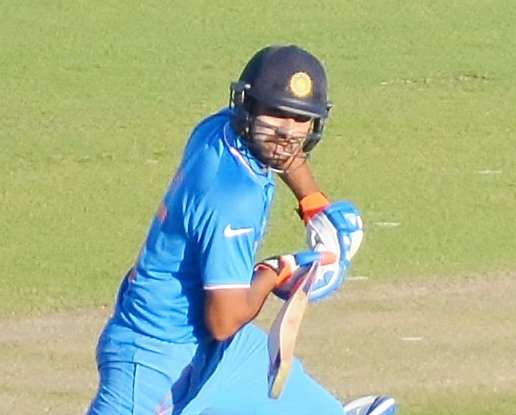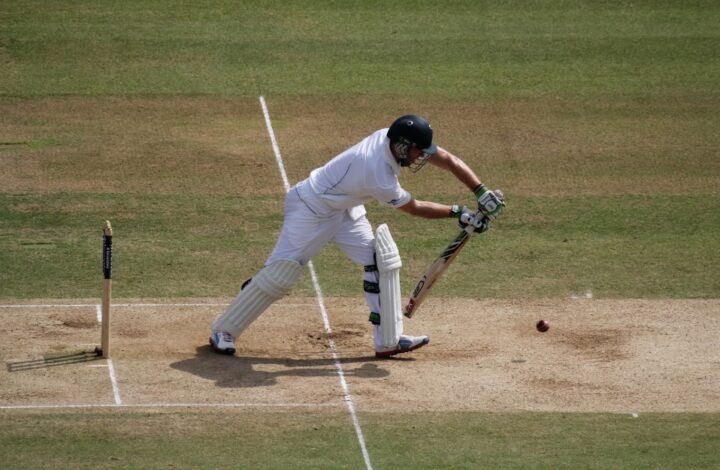There’s not much to celebrate from an English point of view in the second Test. England teams usually collapse on bunsen burners so what we’re witnessing shouldn’t be a surprise. However, what we can do is appreciate the quality of the opposition. Rohit Sharma was class on day 1. Here’s Abhijato’s assessment of one of the most aesthetically pleasing batsmen in the world …
Artists despise being called ‘talented’, because they feel it takes away something fundamental from their pursuit of perfection in their craft. Most artists also realise perfection does not exist. There is always going to be a critic who dislikes Picasso, and an English teacher who does not understand why Shakespeare holds the sway he does over the English language.
Cricket is a romanticised sport. We often find ourselves lost in the poetry written by the willow of someone who can play an effortless cover drive. It is madness, perhaps, to score four double centuries in one-day cricket, a format which provides only the illusion of security.
Batting against the white ball is an art in itself, which has not been deciphered by most batsmen, or even most teams, around the world. Yet, there are just a few who seem to be able to combine the serenity with the madness – people with talent, methods, and a disregard for cricketing convention. Rohit Sharma is people.
He gives laziness a bad name. His elegance is not constructed out of sheer will and his technique has never been developed to perfection with a protractor. The world tries not to allow him to take pride in his effortlessness. Yet, it comes naturally to him. It always has.
For the longest time, the same critics compartmentalised him into a headspace where he was destined to remain an unfulfilled talent. Yes, he does have some fantastic ODI numbers – 7,148 runs as an opener at 58.11 is not shabby. As an aside, it’s the best in the history of the game from the position he plays in. He has the most T20I centuries as well.
But he was forever meant to be the ‘next Sachin Tendulkar’. He matured the day he realised to express himself as not the reincarnation of his country’s greatest batsman, but as someone who is very much a product of his times, and a unique one at that.
Comparing him to an assassin on the cricket field – he’s nicknamed the ‘Hitman’ – might come across as hyperbolic to some. But as his latest innings showed, the method to his madness is here to thrive. He’s transformed himself from a precocious talent to an elderly statesman of the game.
World-weariness is a common symptom in the works produced by mature artists. Rohit Sharma, on the other hand, has always been weary in the way he ambles up to the crease, in his minimalistic footwork, and in his lack of effort towards finishing off his best shots. Most coaching manuals would discourage you from playing the way he does, but they don’t – most coaching manuals also bear in mind most of us will never be able to play the way he does.

Steven Smith’s idiosyncratic works for him like a raucous symphony. His numbers have thrived across all three formats of the game, which has led critics to quietly accepting his unorthodoxy as a side-effect of his greatness. The one person he’s compared to most often is someone from another era – Donald Bradman. And while Rohit isn’t Bradman (no one is), his numbers at home paint an unparalleled picture for the modern era. Whenever he’s batted in his whites within the confines of India – in 16 Test matches, to be exact – he’s scored at an average of 83.55 with seven hundreds and five fifties. That’s Bradmanesque.
This is no mere fluke, and neither is this a vindication. The six innings he played in Australia in India’s historic series victory a few weeks ago show where he is with his Test match batting right now. He’s got all the tools he needs to survive – he can defend everything except for the rippers – and he’s quite clearly got the experience as well.
But in almost all his matches in Australia, he got starts but then got out. This was for one simple reason. If Virender Sehwag revolutionised opening against the red-ball, Rohit Sharma is amending the steps his predecessor invented, and refining the percentage cricket which has now been proven to be an effective way of playing Test cricket.
Rohit Sharma does not seek to merely survive. He seeks to attack, to dominate, and to score. His critics have long asked him to amend his ways to more hostile conditions. Batting on foreign soil and feeling nervous is no fault of his own – but he seldom seems nervous in the ways he steps out to the spinners and the swingers alike. He’s got swagger – and for someone who has so much baggage attached to his ability, he utilises it to play like a man without a worry in the world.
There simply hasn’t been convincing proof thus far that Rohit Sharma is going to come across as an all-time great when his numbers playing away from home are considered in isolation. And there is merit to the argument that the team should have gone with an uncapped player who had proven himself in the India A tours – such as Abhimanyu Easwaran – or a youngster like Gill when an opening spot found itself unoccupied after KL Rahul’s departure from the side a couple of years ago. But the former’s prolific streak has ended, while the latter is now playing in the team alongside Sharma.
The harshest critics will keep hammering home the ‘What Ifs?’ every time he’s the victim of an attacking shot which doesn’t come off, or at the receiving end of a great ball he cannot do anything about. As an opener, he’ll get the great balls more often than any other batsman in the side. And as an opener, he’s decided to take the attack to the opposition at every opportunity he can.
He scored 80 runs off a mere 78 balls in the first session of this Test. He slowed down only as an afterthought, like an artist who realises the climax of his work needs to be comprehensible in order to entertain. There was grit and patience in the way he accumulated the other 80 runs off his innings. Until, of course, he got out sweeping to deep midwicket on 161 off 231 balls– the one shot he played so early and so often that when he was finally caught trying to play it, he must have been as shocked as we were disappointed.
Rohit Sharma gives laziness a bad name. He has worked on his fitness after a streak of injuries in the recent past, and he’s refined his red-ball batting to complement the attacking instincts of this new Indian side. He’s still learning how to channel his white-ball record into his red-ball instincts, which makes him as imperfect a Test cricketer as they come. Yet, he’s also the perfect mentor for his attacking young partner, Shubman Gill.
He knows his critics will always be around, but only as long as he himself remains. And when you’re Rohit Sharma, could you care any less about what they have to say?
Abhijato Sensarma








Flowery, over-written verbiage can’t conceal that there’s a reason why runs scored in Tests when things are toughest are the runs that fans appreciate most and are the true measure of quality. Beating up weakened opposition when things are easiest is a talent of sorts (and all batsmen need to make some runs in these circumstances – Allan Lamb for example too often didn’t) but it’s not the most lovable. Anyone who has a clue about the game values Gooch’s 154* at Headingley or his 116 in Bridgetown more than his triple century.
Hopefully we get one match in this series not decided by the toss. So far, as long as the team winning the toss bats anything like in their first innings, it’s been a foregone conclusion.
I get your point. But then, is there not enough to be loved about Joe Root bashing the worst Sri Lankan attack in a decade with his assortment of sweeps and reverse sweeps? It came against a beaten up opposition, but it’s still an all-time great series performance for him and his team.
As for the Sharma 161, I think it came at a time of intense pressure for the Indian team, hammered in the first Test and under the pump against a confident side which took 3 wickets in the opening session of the match. To do what he did then, in any sense of the word, is ‘great’.
Not everyone’s Ben Stokes and not every day is a World Cup final, alas, but those who do well on those days do deserve the credit they’ve earned for themselves, methinks!
You’re over-egging the pudding here Simon.
Sure you could say that about some of Rohit’s hundreds, but he’s also scored a first-innings double-century at virtually a run a ball in a match where only three other batsmen in the match got to 40; and in the current match, on a pitch that is at best not that easy to bat on, he’s got almost 200 runs so far at a strike-rate of around 65 when only eight batsmnen in the first innings got into double figures, only three passed 22 and only one who batted for more than about a dozen overs scored at more than 40.
Good knock yesterday of course, but so far England have dismissed Rohit 3 times in this match yet he’s still “not out” in his second innings!
Abhijato thank you. A nicely written article that does express the essence of Rohit Sharma. Scoring runs in this Test has been a tough task for almost everyone except Sharma and batting wise he has made the difference to India after winning the toss as Joe Root did in the 1st Test.
Batting is a lot easy when the third umpire is on your side!🤨
Well Ian, Root should be given out today but wasn’t, and I have no idea how Kohli was given out LBW, but there you go. Turns out the 3rd Umpire isn’t on our side either.
Kohli’s certainly looked like it was going over the top. Hawk Eye is very strange sometimes. The on-field umpire is at fault here for me. Just like with Burns in the first innings, he shouldn’t be giving LBWs that are just clipping the stumps.
Burns has suddenly gone from “should he be captain?” to “should he be in the team?”.
He’s already been dropped in the second innings (Pant’s keeping was so, well, pants he didn’t even get a glove on it but for any specialist keeper that was a regulation take).
Speaking as someone who’s worked in India, he should get his hair cut really short. It sounds trivial, but I’m sure he’d feel better in the heat if he did.
The fact remains that with Archer and Anderson opening he would have found it well nigh impossible to play like that. Stone and Broad did ok but neither have the X factor in those conditions.
Moin and Leach bowled like we all knew they would, ok but without consistent threat befitting county standard spinners. Stokes seems a forgotten man, either that or he’s unfit, which seems more likely. Going forward is he ever going to be able to fulfill the third seamer slot again?
Difficult to make an assessment of our team as we’ve had no time to acclimatise. Feel Bairstow should have played after his more mature performances in Galle. Our present top order doesn’t cut the mustard in these conditions and a bit of positivity would have been good. Burns was always going to struggle. Left handers always do against off spin. Great to see a proper keeper back, though I fear unless he makes a hundred or two once Buttler returns he’ll be consigned to drinks monitor again.